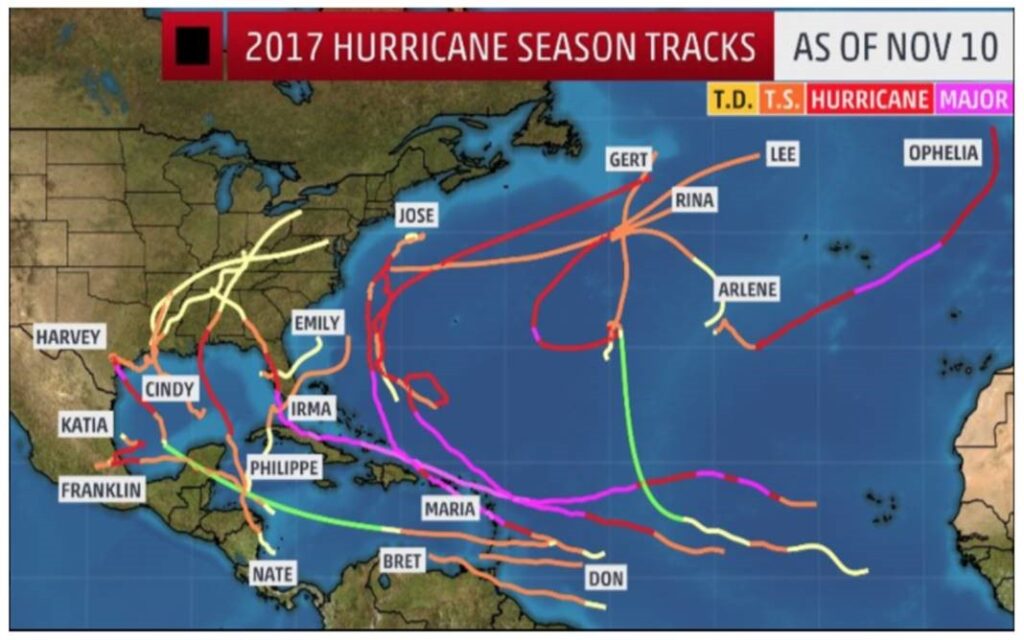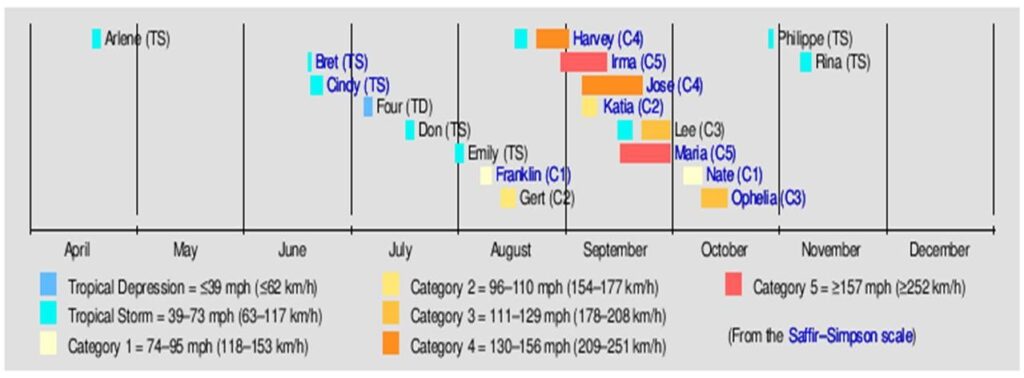
The 2017 Atlantic hurricane season officially began July 1. By then, three named systems had already become storms, foreshadowing what became one of the most active and destructive storm seasons ever. Subsequently, five named storms and one tropical depression formed by July 31, but the associated damage by then was minimal, attracting little notice. However, by season’s end:
The cumulative impact was sobering with notable implications for utilities for 2018.

Source: The Weather Channel
Timeline of 2017 Atlantic Hurricanes/Storms

Source: The Weather Channel
Seven of the 2017 Atlantic Ocean Hurricane/Storms directly impacted the United States. More than 750 Americans were killed and hundreds of billions of dollars in cumulative damage sustained. For the United States, hurricanes Maria, Irma, and Harvey were the most devastating in terms of storm strength, loss of human life, and estimated costs.
2017 Atlantic Ocean Hurricane/Storms Impacting the United States
| Name | Peak Type (Date of U.S. Landfall) | Site(s) Most Impacted | Total Customer Impact | Length of Longest Outage | Lost Revenue by U.S. Utility | Estimated Costs to the U.S. | Additional Comments |
| Maria | Hurricane – Category V (September 20) | Puerto Rico, U.S. Virgin Islands | Officially at least 129 deaths (64 Americans) with some unofficial estimates of more than 500 in Puerto Rico | 30 days after Maria hit Puerto Rico:
· 90% of supermarkets operational · 75% of gas stations operating · 88% without power (~3 million people) · 40% without cell phone service · 29% without tap water (~1 million) |
~80,000 customers were without power due to Irma two weeks earlier when Maria hit and destroyed the power grid, leaving all 3.4 million residents without power | $52 billion | The 10th most intensive hurricane ever |
| Irma | Hurricane – Category V
(September 10) |
Florida (The Keys), Barbuda, and St. Martin | 134 deaths (including 90 in the U.S.) | At peak, 15 million without power. Within 48 hours (9/12), almost 4.4 million homes and businesses in Florida without power; 82% cell phone towers were non-functioning in Monroe County (Florida Keys), 73% were non-functioning in Collier County (Naples), 78% were non-functioning in Hendry County, and an additional six counties had 41-60% of cell phone towers not functioning, including Lee County (Ft. Myers) and Miami-Dade County | FPL (NextEra Energy) had ~5 million customers without power.
Duke Power and Southern Company each reported ~1 million customers without power |
$65 billion | FPL reported dispatching more than 20,000 employees to restore power in the days following landfall |
| Harvey | Hurricane – Category IV
(August 25) |
Texas
(Houston) |
90 people killed (89 in U.S., 1 in Guyana) | By August 28, roughly 280,000 customers without power along the Texas coast and in Houston and the surrounding areas | Circumstances much different due to flooding from intentional release of water from reservoirs | $199 billion | Costliest hurricane ever.
First hurricane to make landfall in U.S. since Wilma in 2005 |
Key Takeaways
Implications
More information
Additional Contributing Author: Tony Gonzalez
This report is part of the VIU Minute series. To view all featured Minutes, please click here.
View MoreSussex Economic Advisors is now part of ScottMadden. We invite you to learn more about our expanded firm. Please use the Contact Us form to request additional information.